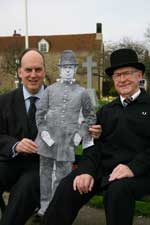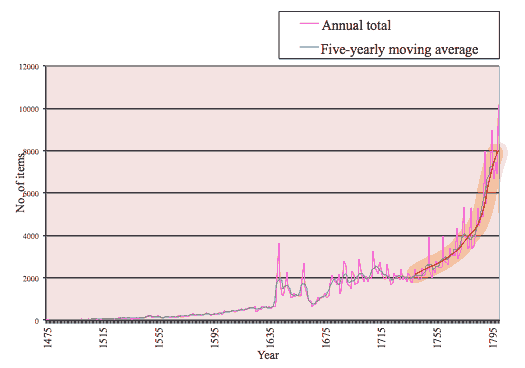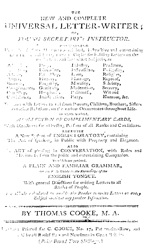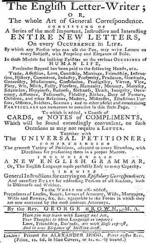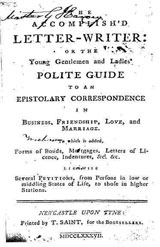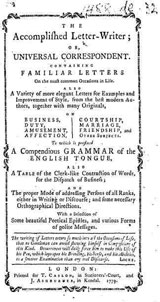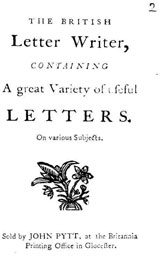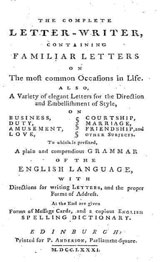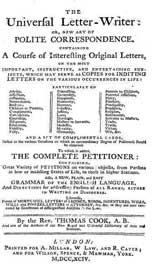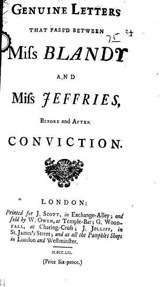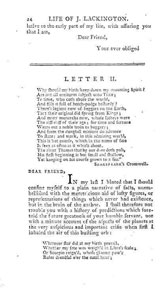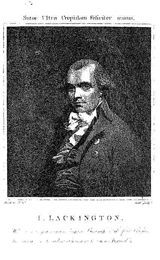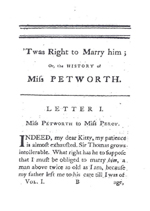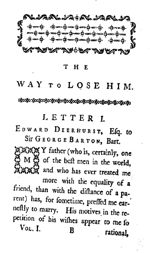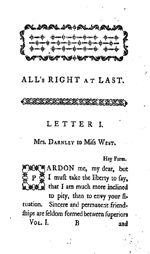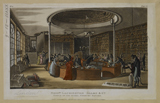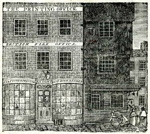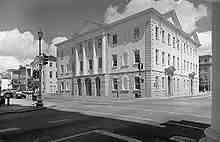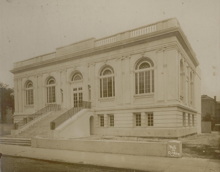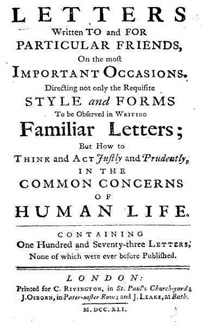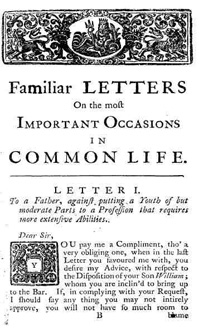Electronic Enlightenment colloquium on the sociology of the letter
Keynote address:
Letters, correspondents and correspondence — James Raven, University of Essex
First, I want to start eccentrically with some personal reflections — and a little out of our time period — but perhaps useful comparatively to suggest connections between letters and publishing.
My children are the latest to ask why I became a historian. Well, the reason is because of my family who never stopped talking about the past. From my earliest years I was immersed in it — my huge extended family, all labourers and farm workers in a specific area of north Essex and south Suffolk — plus some sons and daughters of the empire who set off from the port of Ipswich to travel and then farm across North America — constantly narrated and relived history. My grandmother was one of 12 siblings and my other grandparents came from very large families, and so, including the married-in spouses, I had something like 60 great aunts and great uncles when I was a boy — all of whom had left school at 14 or before and all of whom kept in touch with each other by letter. (I am speaking of course about letters written in what Susan Whyman has called ‘the uncommon register; — or perhaps we should say, pace Hamlet, the ‘very common’ register, where, to quote Susan, ‘its distinctiveness lies in the low social backgrounds of its subjects’) These very common ancestors of mine were amazingly literate, informed, and great letter writers — and keepers of letters. I have hundreds of letters at home from that generation and from up to three generations before — some dramatic letters — some sent from Indian — ie native American — reservations — from the American civil war — and from the Western Front, the Balkans, and from Egypt and India — and many more, apparently more mundane, but equally fascinating in their evocation of a lost world — and of a lost world of the manners of communication.
Why they were kept also long fascinated me — for they were not simply locked away — although there were secret ones that I’ve since inherited — but the letter collections were regularly referred to — an index of family life, a few to reassure and offer comfort, a few to settle debate, or remind people of relatives silenced either by death or distance. Although many letters were not kept (and that touches on another aspect of the circuits of letters — at times when even a letter sent by the post (let alone by hand) could be sent in the morning and received the same afternoon — so for example letters and cards were used to request carts or animals to be moved by a relative or worker from one village to the next by the next day) — so quite apart from short practical notes that wee not kept, there were also serial runs that were used to recount and instruct, and some were used, I recall, to accompany readings from commonplace books. There, the role of a fondly or fearfully remembered school teacher was obvious also. The most quoted poem from these, incidentally, was ‘Meg she was a gypsy who lived upon the moor’. Long acceptance letters received in response to a wedding or christening invitation and letters of condolence were also used as models — I’ve used them myself (and I’m tempted to send some to students who email me (and probably unsuccessfully try to text me), writing along the lines of ‘Hi James, can’t do class today, totally sorry, Tina’. I’m even more tempted to send examples to those who send no apologies at all. And in class, the first reactions to my question about how the students have found reading an epistolary novel like Pamela or Evelina now invariably concern the elaborate — and very unfamiliar — topping and tailing of the letters — the polite forms of address and valediction.
But this also relates to one aspect of these family letters (and therefore of all letters) that has always fascinated me: what one might call the protocol of communication — the way in which letters were addressed and the grammar of their structure — not just of their writing but also of what that means in specific historical context. Some evidence is internal. For most in my collection are grammatically eccentric, and also clearly in dialect, and also misspelt (whatever that actually means) — but there are also common forms and patterns — and the evidence of models — traits common between letters from different sides of my family who did not communicate with one another. For example, many writers created levels of distinction between loved ones — obviously ‘darling’ ‘MY dear’ ‘my very dear’ and just ‘dear’ but also inversion of the dear — eg ‘Richard dear’ at the beginning, rather than ‘dear Richard’. And the closing lines are even more unfamiliar to modern readers of letters — at least to me. Some of the most intimate letters — again on different, independent sides of this collection — letters between husbands and wives — whether asking for clean shirts to be sent or lonely, moving missives waiting for ships to embark to Flanders, or letters between mothers and daughters separated for years by geographical distances which now seem laughably short — these intimate letters and notes are signed off with a full signature — for example:

‘my own darling child — from your loving and affectionate mother and father, Sarah and Samuel Hayhoe’.
The apparent belief is that whatever the endearment, however intimate, the final name on the letter had to be a full one in order to authenticate the person and the feelings — was that common practice the result of instruction, and when did it begin — and indeed end? But did publishing affect this in the provision of models? It is a question I raise given the emphasis of Roger Chartier — and indeed Susan Whyman — upon the reading of manuals of letter-writing for enjoyment, not for slavish copying (whatever their prefaces directed).
Well, that’s simply an introduction, but I want to take up these points in relation to my experience in the archives — mostly eighteenth-century manuscripts and print. From my earliest work it was impossible to ignore that this was the age of the expanded letter, of a huge increase in these volume and length and speed and social range of written correspondence (this is what Kon Dierks in his recent book1 calls ‘an infinity of letter-writing’) — but it was also an age of new forms and expectations — of new interactions between the written and the printed letter — between private and public correspondence — between the letter as agent in transition and initial receipt to the letter as an agent within a kept repository (in exactly the way I just described). Relationships deepened between written communication over varying distances and in varying communities, and the model epistle and the fictional example, often as part of a new narrative technique. Clare Brant has calculated that between 1700 and 1800 more than 21,000 printed items were published that used the word ‘letter’ or ‘letters’ in the title — and that is only in English and also of course excludes many works in letters that did not have ‘letters in the title. — sometimes according to my fiction bibliography up to half of all epistolary fiction published in any one year.

Margaret Georgiana Spencer
But just to go back to that point about letters as archives — their storage and reuse — my earliest encounter with a large collection of letters was through the work of Donna Andrew (we collaborated for a book with John Brewer in the 1980s) and her analysis of the letters sent to Lady Spencer over 60 years — mostly begging letters and Lady Spencer’s filing of these letters to create an extraordinary working archive, the use of which enabled her to send stinging rebukes to applicants for alms who had already written before, been sent something before, or worse, sent something on condition — a condition to which the new letter made no allusion. This was the creation of a record of a communication circuit also, of an uncompromising utilitarian collection of letters — and a mini-industry on the part of the ever letter-writing Duchess.2
This seems to me an important aspect of the European and indeed transatlantic letter in the eighteenth century — the contemporary conservation of letters and the use to which they are put. It is, I think, an important but often neglected area for further discussion, as an activity itself — and commented upon and worried about at the time (whether this be Horace Walpole or the published Chesterfield, or Susan Whyman’s earlier Verneys, or one of my Correspondents — with a capital C — that I’ll be talking about in a moment). It is part of what Malvin Zirker called the new ‘commitment to the letter form’ that crucially straddled and linked but also differentiated both public and private worlds, and can be explored for the development in letters of what Zirker also called ‘emotional richness’, very often relates to questions of intended storage, access, presentation and re-use. Importantly also, storage and retrieval is a hinge between the published, printed letter and written exemplars.
Susan Whyman’s recent book brilliantly describes the impact of letter writing on lowly individuals and she concludes that ‘In practice (Susan likes that term a lot), epistolary literacy offered people three important benefits: they were given ample practice in constructing narratives, they were able to record their life stories, and they could communicate those stories over distances to people outside their neighbourhoods.’ To this I would like to add a fourth — the means by which that record was kept and filtered and reused. This further consideration reinforces the developments in language, in standardization and in the broader productions of tropes and models (even if these models were self-referential rather than being taken directly from letter manuals). In my first book, Judging New Wealth, I was keen to build on the work of Olivia Smith and others who looked at the standardization of rammer, of the production of dictionaries and the like to explore the creation of particular literary stereotypes that served to communicate a special range of values in Britain at the end of the eighteenth century. That language development and the development of literary caricature and stereotype derived from a great range of literature, but especially from drama and novels — and imaginative work in letters. What Susan Whyman again put so well — the way in which the letter — then and now known for its extreme individualism was ‘regimented’ — regimented by prints, lexicographers, and linguists — the way in which standardization of spelling, grammar and punctuated brought an ordered look to letters. This can be chronicled, of course, in the written production — the copperplate taught letter writing — but also from printed models.
I should just insert a few examples here because I continue to be interested in where they were produced - the first two here are published by Cooke and Hogg — at the very time of great take-off in publication numbers -


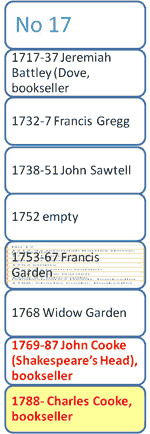
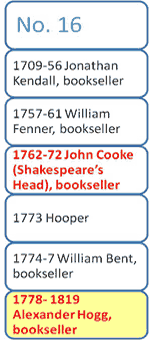
populist and hugely successful — and many not in collaboration — Charles Cooke retired immensely rich.

The mansion Charles Cooke built on the profits of his publishing business . . .
But also some of the most regional of publications:
Obviously, like dictionaries and etiquette books a key seller —
And there was also a significant adoption of the letter in the autobiography, memoirs, travel writing and various other forms of popular production — such as criminal biographies such as that of Mary Blandy — I think for example of the letter form of the memoirs of James Lackington and even of the short — episodic semi-epistolary form of the autobiography of my favourite rogue, the Revd Dr John Trusler:

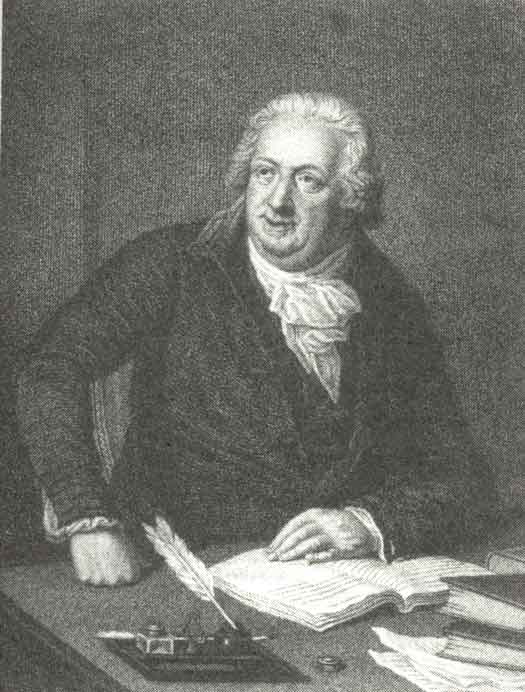
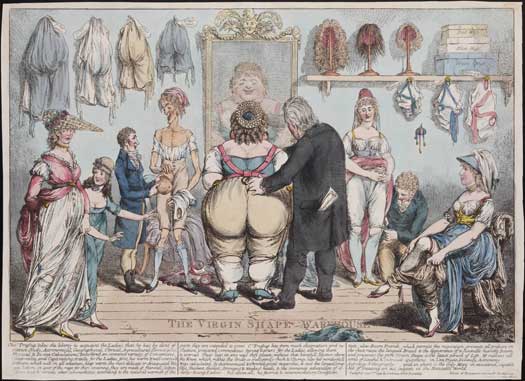
(and Clare Brant is very suggestive here, writing of how familiarity with letters shaped readers; of the sense of scepticism and belief and of public belief in letters as a true representation of the mind.
Earlier work on the popularity of particular literary genres contributed to the demonstration of the rise of the novel — little news there — and fictional narratives transmitted in the form of successive letters bridged the relationship between living correspondents, letter writers and letter receivers — and the public letter and the private letter in an age when advancing transport and postal mechanisms allowed a new range of distribution and faster letter writing activity — and this includes international communication by letter.
These examples of novels in letters are from the Nobles — the greatest novel producers in the mid eighteenth century in Britain — and many from France — and stylised productions — the printers Adlard and Dryden Leach
The protocols here are remarkable — offering standard models in minute form in which letters were represented as constitutive of social realities, not simply reflecting but also, through their distribution and reading, constructing and then reshaping social relationships.
Fiction
Let me then just revisit the public letter as it contributed to the evolution of the popular novel. Here, fiction writers used the exchange of letters primarily to offer authenticity, but the letter form also contributed to narrative suspense, and offered a gentle introduction to novel writing for the novice writer — and some were very poor indeed.

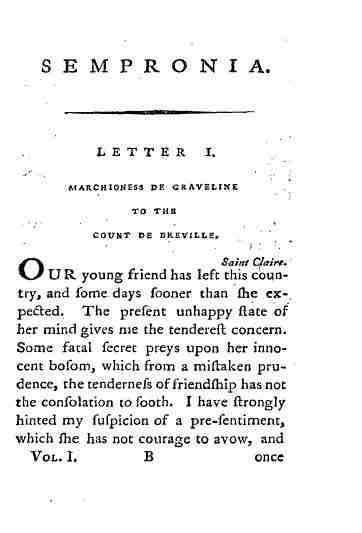
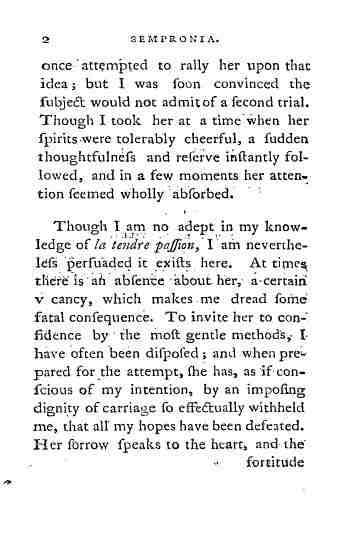
In terms of structure, indeed, probably the most distinctive type of novel in English and French in the eighteenth century was that written in letters. The epistolary novel in English enjoyed a distinguished history from the early models of Richardson (and indeed various earlier exemplars) to the translations of Grafigny, Le Prince de Beaumont and Riccoboni. The renown of the novel in letters was in part a consequence of these eminent archetypes, although it has also been suggested by Ruth Perry that first-person prose writing within the apparently verifiable document was the product of moral doubt — the letter-exchange provided ambiguity and reader-led reconstructions of narrative histories.3 And the main authorities here are, beside Perry, Robert A. Day, Told in Letters; and Frank Gees Black, The Epistolary Novel in the late Eighteenth Century 4
Because the novel-in-letters was an easy form to adopt for the inexperienced or unimaginative writer, and because potentially, it was the most serviceable for domestic and credible settings, its popularity was assured. In the words of the Monthly, endorsing the 1771 Fatal Compliance,
‘the epistolary form is become the high mode of modern romance.’
Fatal Compliance not reproducible — but I have instead the Involuntary Inconstant.

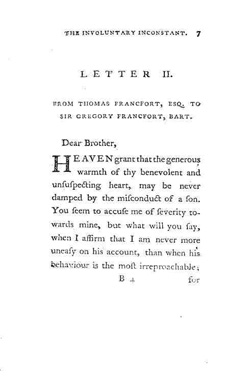
Resulting critical reception was frequently dyspeptic. As one 1758 reviewer wrote of a Noble novel:
‘Clean straw, a dark room, plentiful evacuations, a thin diet, and a total privation of pen, ink and paper, may perhaps make the author of this melancholy piece useful to society’.
I can give some estimates of production in England, but these will, if anything, understate the extent of epistolary fiction, given the number of novels with no surviving copy and where reviews or advertisements give no comment upon narrative form. Where titles to lost novels indicate ‘in letters’ these works are included in the epistolary tally, but the absence of this description is no certain indication that a novel was not written in letters. With this warning in mind, we can say that between 1750 and 1760 new novels in letters averaged no more than a tenth of the annual total of new fiction, but by 1766 and 1768 nearly one quarter annually and in 1769 more than one third of all new novel titles were epistolary.5
Publication of epistolary fiction in English, 1770–17996
| Imprint year | Total novel titles | Epistolary titles | Epistolary titles as % of total |
| 1770 | 40 | 14 | 35 |
| 1771 | 60 | 21 | 35 |
| 1772 | 41 | 20 | 49 |
| 1773 | 39 | 17 | 43.6 |
| 1774 | 35 | 17 | 48.6 |
| 1775 | 31 | 12 | 38.7 |
| 1776 | 17 | 12 | 70.6 |
| 1777 | 18 | 9 | 50 |
| 1778 | 16 | 7 | 43.8 |
| 1779 | 18 | 9 | 50 |
| 315 | 138 | 43.8 | |
| 1780 | 24 | 13 | 54.2 |
| 1781 | 22 | 12 | 54.5 |
| 1782 | 22 | 8 | 36.4 |
| 1783 | 24 | 12 | 50 |
| 1784 | 24 | 14 | 58.3 |
| 1785 | 47 | 20 | 42.5 |
| 1786 | 40 | 15 | 37.5 |
| 1787 | 51 | 22 | 43 |
| 1788 | 80 | 26 | 32.5 |
| 1789 | 71 | 27 | 38 |
| 405 | 169 | 41.7 | |
| 1790 | 74 | 27 | 36.5 |
| 1791 | 74 | 15 | 20.3 |
| 1792 | 58 | 14 | 24.1 |
| 1793 | 45 | 11 | 24.4 |
| 1794 | 56 | 12 | 21.4 |
| 1795 | 50 | 8 | 16 |
| 1796 | 91 | 14 | 15.4 |
| 1797 | 79 | 8 | 10.1 |
| 1798 | 75 | 8 | 10.6 |
| 1799 | 99 | 11 | 11.1 |
| 701 | 128 | 18.3 |
As suggested by my table, at least 30% of all novels published between 1770 and 1790 were in letters. Epistolary novels with imprint dates of 1776, 1777, 1779, 1780, 1781, 1783 and 1784 comprised at least half the annual novel output, and often far more (in 1776 a year of relatively few publications, more than two-thirds of the titles were epistolary novels). The average for both the 1770s and 1780s was remarkably consistent. Just over 40% of all novels from those decades were published in letter form. The turning-point seems to have been in 1791 when only 15 (or about a fifth) of the 74 novels published that year were in letters, and this proportion remained about the same until a further decline to some 10% of the total for each of the three years 1797–99. By the final years of the century, the epistolary form had lost its popularity, swamped, it seems by the diversity and directness of new historical and Gothic narratives that were not well-suited to relation by imaginary letters.
But I must not exaggerate the critical hostility. Because letters offered a form of authenticity — and more adroitly so than the allegedly recovered manuscripts that offered another conceit in narrative form — many of the novels-in-letters were, in fact, well received — I have just selected at random one year — 1770 — here, of the 40 prose novels listed in my bibliography for that year (14 of which were in letters) — these are where the reviews specifically mention the letters: (most, not all, are enthusiastic and although this was a random choice it reveals interesting results).7
ANON.
FATAL FRIENDSHIP; A NOVEL. IN TWO VOLUMES. BY A LADY.
London: Printed for T. Lowndes, at No. 77, in Fleet-Street, 1770. I 252p; II 239p. 12mo. 5s (CR), 5s sewed (MR).
‘. . . the catastrophe is affecting, while the letters are written in a lively agreeable style.’
MR 42: 488 (June 1770) [John Noorthouck]
ANON.
LETTERS BETWEEN AN ENGLISH LADY AND HER FRIEND AT PARIS. IN WHICH ARE CONTAINED, THE MEMOIRS OF MRS. WILLIAMS. BY A LADY. IN TWO VOLUMES.
London: Printed for T. Becket and P. A. De Hondt, in the Strand, 1770. I vi, 241p; II 287p. 8vo. 6s (CR), 5s sewed (MR, LC).
‘An air of reality, without the least intermixture of any appearance of fiction, runs through the whole, both of the letters and the memoirs; so that if, possibly, every circumstance related, be not strictly fact, this is more than the candid Reader will suspect, in the perusal: for every thing wears the face of nature and probability. Here we have nothing of wonderful adventure, no extravagant achievements, no romantic incidents.’
MR 42: 330 (Apr 1770)
ANON.
LIFE, ADVENTURES AND AMOURS OF SIR R P WHO SO RECENTLY HAD THE HONOUR TO PRESENT THE F--- ADDRESS AT THE ENGLISH COURT.
London: Printed and Sold by J. Brough, in the Strand, near Temple Bar, 1770. iv, 70p. 8vo. 1s 6d (CR, MR).
‘This production can be considered in no other light than a Grub-street catchpenny, as it contains little more than a compilation of some letters which appeared in the Newspapers relative to this extraordinary adventurer, hashed up by the writer into the form of an eighteen-penny touch.’
CR 29: 237 (Mar 1770)
ANON.
THE MEMOIRS OF MISS ARABELLA BOLTON. CONTAINING A GENUINE ACCOUNT OF HER SEDUCTION, AND THE BARBAROUS TREATMENT SHE AFTERWARDS RECEIVED FROM THE HONOURABLE C-- L----, THE PRESENT SUPPOSED M----R FOR THE COUNTY OF MIDDLESEX. WITH VARIOUS OTHER MISFORTUNES AND EMBARRASSMENTS, INTO WHICH THIS UNHAPPY YOUNG WOMAN HAS BEEN CRUELLY INVOLVED THROUGH THE VICISSITUDES OF LIFE, AND THE VILLAINY OF HER SEDUCER. THE WHOLE TAKEN FROM THE ORIGINAL LETTERS OF THE SAID C-- L---- TO DR. KELLY, WHO ATTENDED HER IN THE GREATEST MISFORTUNES AND DISTRESSES UNDER WHICH SHE LABOURED; AND ALSO FROM SEVERAL ORIGINAL LETTERS FROM DOCTOR KELLY AND MISS BOLTON, AND FROM OTHER AUTHENTICATED PAPERS IN THE HANDS OF THE PUBLISHER.
London: Printed for I. Fell, No. 14, Pater-noster Row, 1770. I xxii, 213p; II xi, 228p. 12mo. 5s (CR), 2s 6d each vol. (MR).
‘the present wretched production; in which it is difficult to pronounce whether the hero of the tale, or the tale-teller, makes the worst figure’
MR 42: 251 (Mar 1770) vol. 1; MR 43: 65 (July 1770) (based on letters published in a newspaper.)
[BANCROFT, Edward].
THE HISTORY OF CHARLES WENTWORTH, ESQ. IN A SERIES OF LETTERS. INTERSPERSED WITH A VARIETY OF IMPORTANT REFLECTIONS, CALCULATED TO IMPROVE MORALITY, AND PROMOTE THE OECONOMY OF HUMAN LIFE.
London: Printed for T. Becket, in the Strand, 1770. I 263p; II 284p; III 220p. 12mo. 7s 6d (CR), 7s 6d bound (MR).
‘The History of Charles Wentworth is full of instruction: every page of it immediately relating to the hero is particularly so: and those young men whose lively passions hurry them to dangerous indiscretions, may receive excellent lessons from his letters: they may also receive the greatest encouragement to act upon every occasion with honour and with prudence’
CR 29: 358–64 (May 1770), (p. 363).
FRAMÉRY, [Nicolas-Étienne]; BROOKE, [Frances] (trans.).
MEMOIRS OF THE MARQUIS DE ST. FORLAIX. TRANSLATED FROM THE FRENCH OF MONS. FRAMERY. BY MRS. BROOKE.
London: Printed for J. Dodsley, in Pall-Mall, 1770. I xii, 191p; II 189p; III 259p; IV 215p. 12mo. Vols. 1–4 12s (CR) Vols. 1–2 5s (MR); vols. 3–4 5s sewed (MR).
‘In this species of composition, there are few publications more entertaining than the Memoirs of the Marquis de St. Forlaix. They are written in the form of letters, which succeed each other in proper order; and the incidents on which they turn are natural and probable’
MR 43: 362–5 (Nov 1770) vols. 1–2; MR 44: 48–51 (Jan 1771) vols. 3–4 [Gilbert Stuart], (p. 363).
Again, it is the protocol of communication that is foremost in the positive critical reception — and its transgression that brings greatest wrath from the reviewers. The form of address used and how it works to create authenticity as well as entertainment and instruction. — and the use of the letter in fiction adds, I think, to the discussion of he complexities’ of eighteenth-century communicative practice in which, to quote Clare Brant, ‘the varied and often unpredictable circulation of letters confounds simple distinctions between public and private’. Likewise, Harriet Guest’s criticisms of Habermas (among many critics) in which ‘the analogy of spheres becomes a hindrance’ are greatly reinforced by such study of the letter — in all its forms, including the fictional.
Take for example, as another instance, and here I return to the archive, how letters contributed to the development of publishing and bookselling — those sent as orders from customers. In reconstructing publishing and reading history, I have examined hundreds of letters sent by customers to publishing-booksellers and retail booksellers as the network of outlets and entrepot increased — and crossed the Channel and the Atlantic — with the strategic involvement of newspapers — published by many of the regional booksellers and printers (indeed for whom the newspaper was a critical business prop). The isolation of many of these correspondents is very evident — dozens of graduates sent as vicars and rectors to remote Cornish parishes, for example — their letters to their booksellers reveal a desperate yearning to connect — and a key contribution to the hugely increased traffic in book orders — mostly — at least as the originating location — London.

A view of the Royal Exchange, where you can see the group of bookshops in the center of the picture.
But we also see the increase in institutional customers and hence also the Correspondent for those societies — he or she who drafted letters on behalf of a society or club. These were usually letters to order books and equipment — but also to solicit opinion. Many such groups were often isolated (just like my Cornish vicars) — and nowhere more so than in South Carolina — the focus of another, earlier research project.8
In the book trade, it was transatlantic exchange of hand-written correspondence and direct meetings between printers, booksellers, and customers that refined methods for negotiating credit, balancing supply and demand, and overcoming a hostile ocean.
The Charleston Library Society
An epigraph from Horace ‘caelum, non animum mutant qui trans mare currunt’ was adapted by the colonist George Mason when writing in 1766 to the Committee of Merchants in London: "In crossing the Atlantic Ocean, we have only changed our climate, not our minds: our natures and dispositions remain unaltered." The Charleston Library Society was founded by a dozen or so very young men in 1748 to prove that the civilization of Britain and Europe was transportable and sustainable. To its members the Society answered both the needs of colonial social ambition and a quest for connections. The library offered tangible affiliation to a European and to an intellectual community.
Great hopes were raised by the foundation of Library Societies, despite some supercilious reportage in London. A front-page essay on the state of Rhode Island in the London Chronicle in 1775 declared that:
Arts and sciences are almost unknown; except to some few individuals; and there are no public seminaries of learning; nor do the Rhode Islanders in general seem to regret the want of them. The institution of a library society, which has lately taken place, may possibly in time produce a change in these matters.
Many of these Societies elected, at their annual meeting a Correspondent — and the performance of that Correspondent was closely monitored.
Miraculously, at Charleston — and it became the basis of my study — the Correspondent’s letterbook survives (that is te volume of copies of all letters despatched on behalf of the Library Society from about 1748 to 1811).
The value of the Charleston letter-book is threefold: it details the literature bought, the booksellers contacted, and the mechanics of ordering the books and getting them across the ocean. But it was also an archive, and in addition, the letter-book offers commentary on its own construction.
In the first place, the Charleston Library Society's "Copy Book of Letters" confirms that the Library Society needed to retain (and preserve) an accurate master copy not only as a simple record but also because secretary-correspondents were required to send out several copies of the same letter. Sometimes further copies were also demanded. In establishing the master record, the copying from the original letters appears to have been good but not always meticulous. Despite considerable variation between Secretaries, the hand is usually clear, but marginal comments on the ships used to convey the letters are prone to error and correction. More revealing is what the letters suggest about the role of the original writing and copying. It is clear that the letter-book was used as a record to be consulted by the library committee and library society members to ensure continuity and to check past ordering. The record was especially vital to re-establish correspondence following the Revolution.
From the 200 or so letters sent before 1800, the overall impression from the titles ordered over these sixty years is of a determined but somewhat clumsy attempt to emulate the learned societies of Britain and Europe. The anxieties and frustrations of the book ordering process led to the appearance of bluster and, occasionally, not a little ignorance. The mercantile and planter wealth that was essential to support this library in South Carolina must also have suggested a certain arrogance in some quarters in London. Yet the cause was a noble one — and one attended by many difficulties. The isolation that lent the enterprise both its vigour and urgency was a very real challenge that had to be overcome by methods not confronted by similar institutions in Europe.
I should also reflect upon problems, however — of the Charleston Library Society Copybook of Letters as a historical source. There is a natural bias in the letters from Charleston toward highlighting misunderstandings, delays, and failures. That is what many essentially business letters were for. As a result, the accomplishment of the Society's various dealings with the London correspondents is not given equal attention. Even at the time that they were written, however, the letters' relentless cataloguing of error, with little acknowledgment of success, clearly frustrated the development of cordial business relationships between bookseller and Library. There is no mistaking the intemperate tone often adopted by the Society's Correspondent.
The Correspondent’s crisp, sometimes accusatory language in his letters was the more problematic given that only sustained understanding between the parties secured the smooth operation of such a trade. The most successful transatlantic commercial ventures, and certainly the continuation of them, were the result of sound communication — ie good letter-writing was essential to the construction and maintenance of what peter Mathias called the face-to-face society where credit was dependent on trust. Given the distances and obstacles involved, and in the absence of the financial institutions taken for granted in later years, carefully nurtured trust between partners — as well as tolerance during financial sloughs — was essential to the conduct of business. Given the relative frequency with which members of Charleston's elite resided in London, where they made direct contact with booksellers and other tradesmen, personal relationships were also developed and nurtured.
The strongest bonds between letter-writers and business partners across the Atlantic were familial. The transatlantic booktrade was certainly no exception to this. As pronounced as kinship between book merchants, were family ties amongst those supporting their trade, between colonial traders, sea captains, and those offering bill-broking and insurance. The Charleston Library Society letters offer a further demonstration of the intimacy of commercial, seafaring and — in this case — literary and scientific communities. Their closeness ensured not only confidence but a rapid and accurate exchange of information. Most of the letters sent out by the Society, for example, were appended to letters written either on the day or on the day before the ship cleared out from port.
But more crucially, the Correspondent and the "respectable bookseller" elected at every anniversary meeting of the Library Society was to be a good judge.
As I have written elsewhere — one of the greatest honours to be avoided in the eighteenth century was election as Bookseller (and they were also elected!) to the Charleston Library Society.
And the Correspondent was charged with the composition of each letter which was then discussed and approved by committee. The specifics (if not always the tone), they realised, had to be right. It seemed all the more frustrating when after such care, instructions were apparently misunderstood or ignored. Having sacked James Fletcher as Bookseller for "not attending to the spirit of the above General Instructions", the Correspondent warned his successor, William Nicoll, that small, sewed collections of plays and pamphlets "are not to be sent but by order of the Society". When Nicoll was given more freedom after the war to send across his own selection of publications he was nevertheless soon dismissed, largely because of his perceived failure to adhere to the letters’ sacrosanct "Directions." He was especially censored because he had dared to send the Library some of the "plainest and most ordinary editions," just, indeed, as his predecessor, Fletcher, had seen fit to send over "paltry" editions which the Society had duly returned.
This leads me to broader considerations — the bewildering diversity of experience created by local, national and imperial geographies. Wealth, status, occupation and gender produced significant social variety in the new settlements. Even in British North America, Welsh, Scottish, Irish, German, Swedish, Finnish, Dutch, Italian and French Huguenot settlers — and correspondence — arrived, and letters sent back to home communities increased as much with isolation as with success and confidence. Which transatlantic and trans-national connections mattered most and needed stabilizing? Who was best served by them and, indeed, which culture was to be transmitted? Despite the growing integrative influence of advances in commercial and communications infrastructure, the British Atlantic world clearly remained disorderly and ambivalent. As Phyllis Whitman Hunter has written, this empire was not unified but a patchwork of intersecting localities connected by the coming and going of seafaring vessels. The influence of these fleeting connections lived on and developed in local ways even after the ‘various worlds’ had slid apart. But without constant, dependable connections, for many, decentralized and myopic parochialism remained the rule.9
With Leslie Howsam, I’ve just put together a volume — to be published in 2011 — which aims to revisit Atlantic communication history.10 Over the past decade or so, various concertedly Atlantic histories have promoted integration, and engaged separately with countervailing social and cultural trends (as impediments to that process), As Nick Wrightson has written, this threatens to undermine past work, because British and American historians typically analysed the interactions between different individuals, communities, structures and geographies precisely to illuminate how integration and diversity were able to coexist in their respective societies.
In this way, letters are crucially important to a new Atlantic history. As letters reveal, in terms of social and cultural life as well as governance, the British Atlantic might be regarded as a ‘negotiated empire’.11 As Wrightson has so effectively argued, a sprawling system was held together as much by the networks of connections that private individuals bargained to build in their varying local contexts (while attending to their particular needs) as by overarching political, institutional, or ideological relationships. Such ‘circuits of information’ made transatlantic communities possible. In turn, transatlantic society emerged from the overlap and intersection of these communities. When contemporaries tried to visualize transatlanticism, they drew upon their idea of their own social networks. This was, as T.H. Breen put it, ‘an empire not of formal institutions [and grand designs] but of common men and women making decisions about the quality of their lives, of thousands of people on the move, a human network’.12 Negotiations over distance like these were often, given existing levels of literacy and systems of communication, necessarily conducted in writing.
We might conclude then that the British Atlantic was indeed ‘a literate empire, a paper empire’, relying on the infrastructure of regional and long-distance communication to maintain relationships by letters.13 And, like microhistories, detailed case-analyses of correspondence can ‘test and refine standing generalizations’ or refine syntheses by demonstrating that they are ‘based more on prescriptive literature and slightly-informed assumptions than empirical, archival evidence’14
Only by more concertedly incorporating this approach — what could be called a ‘social history of communication’ — can Atlantic history fulfil what John Elliot saw as its ultimate purpose: the explanation of those interdependent ‘movement[s] across and around the Atlantic basin, of people, commodities, cultural practices, and ideas’.
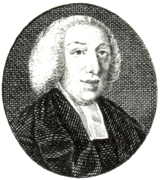
Dr John Trusler
‘Before the invention of printing there were but few learned men even Kings could not write… and perhaps it was as well if not better for the world that it was so. Could we restrain then that Inundation of books of which printing is the origin... Had the lower class of men not been able to read — Had there been no Ale house Orators, Paine’s Book wou’d not have done the mischief it did, nor would the invention of Printing have been enabled so readily to disseminate principles so hostile to the order of Government’
Conclusion
My concluding thoughts focus on the protocols (and in the transatlantic context, on the recent work of Kon Dierks with which I opened). Susan Whyman has written that ‘in practice letters forced writers to decide how to address and send ‘services’ to people of different ranks. As they did so they had to consider their own identities and relationships with the addresses’ — and I do so agree with Susan — through letters ‘negotiations about social status were constantly taking place’
But this is not quite the conclusion of Kon Dierks in his stimulating book In My Power. In this, as he admits, he is heavily influenced by the internet experience — by the receipt of emails — like those from my students I mentioned before — and he stresses growing informality as well as rapidity. In this, the comparison between aspects — not all- but some aspects of the new information age can be misleading — the comparison is helpful in uncovering the experience of sending and receiving and storing and retrieving information in the eighteenth century — but not I think in specific protocols — ie in the tensions between formality and informality. Letter exchange, I would argue, served to reinforce and even create certain new formalities and create certain distances while offering and sustaining and strengthening connections.
The production of letter book manuals was indeed driven by small entrepreneurs like Cooke and Coote and the results did inform new modes of socialization, but I wonder about Kon’s conclusion that letter writing was the instrument of a social myopia — an absence of social ethics. Do we agree with this? Kon writes of a ‘universality’ of experience in letter-writing — the Universal Letter Manual (in which all save slaves are included) and he writes of an inclusiveness that created new social formations. This conference is an exciting forum to test that argument.
— James Raven, University of Essex
Keynote presentation 2010
1 Konstantin Dierks, In My Power: Letter Writing and Communications in Early America (Philadelphia,2009).
2 John Brewer and Susan Staves (eds.), Early Modern Conceptions of Property (Los Angeles, 1995):
3 Ruth Perry, Women, Letters, and the Novel (New York, 1980), p. xi.
4 Robert A. Day, Told in Letters: Epistolary Fiction before Richardson (Ann Arbor, 1966); Frank Gees Black, The Epistolary Novel in the late Eighteenth Century (Eugene, 1940).
5 James Raven, British Fiction 1750–1770: A Chronological Checklist of Prose Fiction Printed in Britain and Ireland (London, New York and Toronto, 1987), p. 12.
6 Taken from James Raven,‘The material contours of the English novel, 1750–1830’, in Barry Ive and Jenny Mander (eds.), Remapping the Rise of the European Novel 1500–1850 (Oxford: Voltaire Foundation, 2007): 101–26; and Peter Garside, James Raven and Rainer Schöwerling (eds.), The English Novel 1770–1829 2 vols.(Oxford, 2000).
7 Taken from Garside, Raven and Schöwerling (eds.), The English Novel 1770–1829, vol. 1.
8 James Raven, London Booksellers and American Customers: Transatlantic Literary Community and the Charleston Library Society, 1748–1811 (Columbia, SC, 2002).
9 See Nicholas Wrightson, ‘Franklin’s Networks: Aspects of British Atlantic Print Culture, Science, and Communication c.1730–60’ (Oxford University, D.Phil. thesis 2007), Nicholas Wrightson, ‘ “[Those with] Great Abilities Have Not Always the Best Information”: How Franklin's Transatlantic Book-Trade and Scientific Networks Interacted, ca. 1730–1757’, Early American Studies 8: 1 (Philadelphia, PA, 2010), and R.W. Harms, The Diligent: a voyage through the worlds of the slave trade (Reading, MA, 2002), xix-xx.
10 Leslie Howsam and James Raven (eds.), Books between Europe and the Americas Connections and Communities, 1620–1860 (Houndsmills, 2011).
11 C. Daniels and M.V. Kennedy (eds.), Negotiated Empires: centres and peripheries in the Americas, 1500–1820 (New York, N.Y., 2002).
12 T. H. Breen, ‘An Empire of Goods: The Anglicization of Colonial America, 1690–1776’, Journal of British Studies, 25 (1986): 467–99 (p. 472).
13 See Ian Steele, English Atlantic, p. 265.
14 Wrightson, citing E. Muir ‘Introduction: Observing Trifles’, in E. Muir and G. Ruggiero (eds.), Microhistory and the Lost Peoples of Europe (Baltimore, MD., 1991), p. viii.

